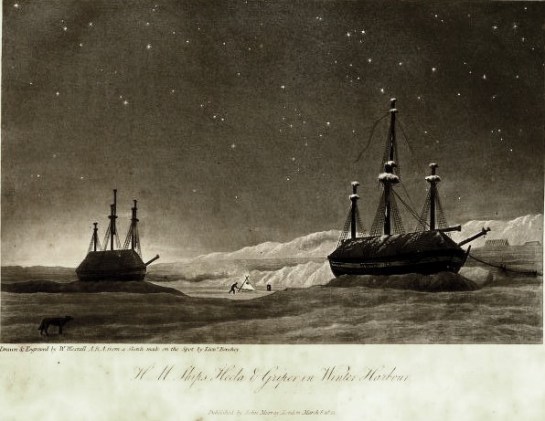
image courtesy of the Providence Athenaeum
The Wonder Show will be touring a performance in late spring based on the content from Parry’s journals which are held at the Providence Athenaeum. Below is a description of the exploration.
On the 16th of January 1819, Captain Parry was appointed to the command of his Majesty’s ship Hecla and the Griper. The object of the expedition was to discover a northwest passage into the pacific. Everyone engaged was to receive double pay. Each man on board took in provisions of essence of malt and hops, limeade, fresh meats and soups preserved in tin cans –an invention so new that can openers were not yet invented!
Blocked by heavy ice, they went south for more than 100 miles into Prince Regent Inlet before turning back. Continuing west they passed 600 miles west of Lancaster Strait which entitled them to a £5,000 reward offered by Parliament. Finally blocked by ice they turned back to a place Parry called Winter Harbour on the south shore of Melville Island. Cutting their way through new ice the ships reached anchorage on September 26th, 1819. Covering both ships in a heavy burlap material, the crew was frozen in for the next 10 months, three of which were in total darkness and reached a temperature of −54° F.Captain Parry kept the men busy with the introduction of a theater and newspaper. Theatrical entertainments took place regularly once a fortnight and continued to prove a source of infinite amusement to the men. The North Georgia Gazette was a source of great amusement as well. On November 4th 1819, the sun made its last appearance above the horizon for three months and on the evening of the next day the doors of the Arctic Theatre Royal were opened at half-past six, with a performance to begin at seven, “Miss in Her Teens.” Parry played Fribble and lieutenant Beechey, the lovely Miss Biddy.
Parry’s journals show how alive he was to the mysterious influence of the mind upon the body. For him, the truest defense against scurvy, depression, and decline was to keep the mind creatively engaged:
“The astonishing effects produced by the passions of the mind, in inducing or removing scorbutic symptoms, are too well known to need confirmation or to admit of doubt; those calculated to excite hope, and to impart a sensation of pleasure to the mind having been invariably found to aid in a surprising manner the cure of this extraordinary disease, and those of an opposite nature to aggravate its fatal malignity.” -Captain Parry

image courtesy of the Providence Athenaeum

